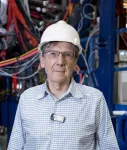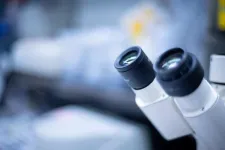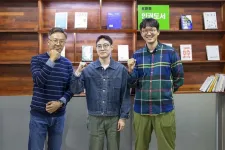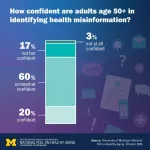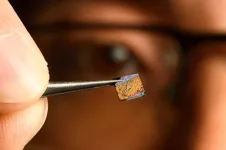(Press-News.org) NEWPORT NEWS, VA – This year, the U.S. Department of Energy's Thomas Jefferson National Accelerator Facility celebrates the 40th anniversary of its founding to probe the secrets of the subatomic universe. And for 39 of those years, esteemed physicist Volker D. Burkert has been an important part of its mission.
Now, Burkert is being honored for his contributions to advancements in experimental physics with the prestigious Tom W. Bonner Prize in Nuclear Physics. The citation reads: “For exemplary leadership in the development of high-performance instrumentation for large acceptance spectrometers that have enabled breakthroughs in fundamental nuclear physics through electroproduction measurements of exclusive processes."
The Bonner Prize has been awarded each year since 1964 by the American Physical Society’s (APS) Division of Nuclear Physics as its highest honor to recognize outstanding experimental research in nuclear physics.
For Burkert, this includes serving as group leader of Jefferson Lab’s Experimental Hall B and shaping its physics program for years, as well as developing the concept of the high-precision detector package for the lab’s powerful Continuous Electron Beam Accelerator Facility (CEBAF). He was also involved in the construction and operation of this detector — the CEBAF Large Acceptance Spectrometer, or CLAS — and later he led the conceptual design of the CLAS12 that was constructed for the upgraded CEBAF. CEBAF is a DOE Office of Science user facility that currently supports the research of more than 1,900 nuclear physicists worldwide.
“Naturally, I am thrilled about receiving the award, though mindful that, while individual initiative is important, it is also an award that honors the science achievements of the research teams and of Jefferson Lab’s discoveries in nuclear science,” Burkert said. “None of this would have been possible without the generous funding of cutting-edge science by the U.S. Department of Energy.”
The prize will be officially presented at a future APS meeting and includes an award of $10,000 and a certificate citing a recipient’s scientific contributions.
‘Something we didn’t know before’
Originally from the town of Ellwangen in southern Germany, Burkert got his first taste for experimental physics while in high school.
“For me, the fascinating aspect of experimental physics is that we can set up some simple experiment, we can predict the results considering the underlying laws of physics and, if we did everything right, we get the results we had predicted,” he said. “That means our experimental apparatus is correctly constructed and, knowing this, we can use it in experiments to study phenomena whose origin we a priori didn’t know, and we have some confidence that the new things we observe are real and tell us something new about nature we didn’t know before.”
In 1975, Burkert earned his doctorate from the University of Bonn, where he was also a research associate and assistant professor. From 1980-82, he was a scientific associate at CERN in Switzerland on a research project that resulted in the first direct determination of the gluon structure function of the proton.
He first came to Jefferson Lab — then known as CEBAF — in 1985 for a summer workshop on defining the scope of the CEBAF science program. By November, he was a staff scientist helping to shape the future of the nascent national lab.
The facility had already developed the concept of a Large Acceptance Spectrometer (LAS) for photonuclear physics with a real photon beam, but there was a strong desire to develop it into a detector that could also accommodate experiments with an intense electron beam. Burkert already had experience in this area from his doctoral project, so he took on the challenge to lead the design and construction of the necessary additional detector systems.
In 2003, Burkert was appointed Hall B group leader, overseeing a team of physicists, engineers and technicians on a research program focused on the study of the structure of protons, neutrons and nuclei using high-energy electron and photon beams, polarized and unpolarized hydrogen and deuterium targets with the CLAS system.
For his CLAS research, Burkert initiated the N* program that included the search for the “missing” excited states of the proton, predicted by quark theory, and reveal their internal structures, toward the goal of fostering a better understanding of a critical phase of the evolution of the universe.
One key discovery from CLAS data came in collaboration with colleagues Latifa Elouadrhiri and Francois-Xavier Girod. The three used published electron scattering data from CLAS and analyzed the data in a way that connected them to mechanical properties of the proton, in particular the physical pressure distribution.
“The stunning results showed that the peak pressure inside the proton exceeded the estimated pressure in the most densely packed known objects in the universe — the cores of neutron stars,” Burkert said. “These results became an unexpected revelation to the nuclear physics community and were discussed in multiple news outlets and the international press.”
Their breakthrough findings were published in the peer-reviewed science journal Nature.
Studying a microsecond moment
Among his other honors, Burkert was elected an APS Fellow in 2004. He received the Commonwealth of Virginia Outstanding Scientist Award in 2019, in part for his leadership in expanding the CLAS detector’s capabilities. That year, he stepped down as hall leader and became a principal staff scientist in Jefferson Lab’s Experimental Nuclear Physics division.
Since 2020, he has been on the leadership team of the Electron-Ion Collider (EIC), a next-generation particle accelerator that DOE is building at Brookhaven National Laboratory in New York in partnership with Jefferson Lab. The EIC is designed to investigate gluons — the force-carrying particles behind the strong force that “glues” the building blocks of matter together.
Burkert has been a key player in Jefferson Lab’s history of furthering our understanding of the creation and tantalizing mysteries of the universe.
“The science that is being done at Jefferson Lab is largely related to the physics of the strong interaction, or hadron physics,” he said. “Everything related to the strong interaction happened in the history of the universe just microseconds after the Big Bang when the strong interaction became manifest and the proton, the nucleus of the hydrogen atoms, was formed and remained the only stable matter particle to this day.
“In the transition from the state of the universe as a ‘soup’ of quarks and gluons, called the quark-gluon plasma, to the proton, the football stadium-size universe was filled with all the extremely short-lived excited baryon and meson resonances that we now explore and discover at Jefferson Lab energies as well in other accelerator facilities at higher energies.
“Exciting these states now in isolation enables physicists to understand the processes that occurred 14 billion years earlier in this microsecond moment. Including all the excited hadrons discovered during the past 70 years enabled physicists to develop models that provide insight into the very fast but smooth transition of the early universe from the quark-gluon phase to the hadron phase.”
Burkert is author and co-author of more than 375 articles published in first-tier journals. In 2022, he was part of the editorial team that generated the volume “50 Years of Quantum-Chromodynamics.”
Further Reading
Volker Burkert Named Virginia Outstanding Scientist
Quarks Feel the Pressure in the Proton
Volker Burkert, Ph.D., 2019 Virginia’s Outstanding Scientist
Hall B Scientific Staff Bios – Volker D. Burkert
By Tamara Dietrich
-end-
Jefferson Science Associates, LLC, manages and operates the Thomas Jefferson National Accelerator Facility, or Jefferson Lab, for the U.S. Department of Energy's Office of Science.
DOE’s Office of Science is the single largest supporter of basic research in the physical sciences in the United States and is working to address some of the most pressing challenges of our time. For more information, visit hMps:// energy.gov/science.
END
Honoring a career of outstanding achievement
Jefferson Lab’s Volker Burkert is chosen to receive the 2025 Bonner Prize in Nuclear Physics
2024-10-16
ELSE PRESS RELEASES FROM THIS DATE:
MSK research highlights, October 15, 2024
2024-10-16
A new tactic for overcoming breast cancer drug resistance
The most common type of breast cancer, estrogen receptor positive, has been effectively treated with hormone therapy combined with drugs that block cell division called CDK4/6 inhibitors. However, it has been impossible to predict how long people will respond to this drug combination. In some patients, the disease is controlled for years, but in others, the cancer starts progressing again after just a few months. This presents ...
Hot news flash: Menopause can impact a woman’s heart health
2024-10-16
DALLAS, Oct. 16, 2024 — The risk of heart disease increases with age for most people, however, for women that may be even more true. The menopause transition, those years leading up to and through menopause, is a time of increasing heart disease risk, according to an American Heart Association scientific statement published in the flagship journal Circulation in 2020.
“While many people think that breast cancer is the leading killer of women in the U.S., in ...
Standing more may not reduce cardiovascular disease risk, could increase circulatory disease
2024-10-16
EMBARGO: SYDNEY: 17 October 2024, 00.01 | NEW YORK: 16 October 2024, 09:00
Standing more may not reduce cardiovascular disease risk, could increase circulatory disease
Standing has gained popularity among people looking to offset the harms of a sedentary lifestyle often caused by spending long days sitting in front of the computer, television or driving wheel. Standing desks have become a popular option among office workers, and in other industries like retail, workers may opt to stand instead of sit.
However, their efforts may not produce the intended result. New University of Sydney research has shown that over ...
Video series aims at improving indoor air quality
2024-10-16
Improving indoor air quality is the goal of a new video series developed by experts at the University of California, Davis in collaboration with the California Department of Public Health. Aimed at building and facility managers, the videos distill the science of air quality into steps building and facility managers can take to remove pollutants, including viruses, from the place we spend most of our time -- indoors.
“The goal is to help people understand the issues around indoor air quality, how it is related to disease, and what managers can do to make it better,” said Professor Chris Cappa, chair of the Department of Civil and Environmental ...
Men and women process pain differently, study finds
2024-10-16
In a new study evaluating meditation for chronic lower back pain, researchers at University of California San Diego School of Medicine have discovered that men and women utilize different biological systems to relieve pain. While men relieve pain by releasing endogenous opioids, the body’s natural painkillers, women rely instead on other, non-opioid based pathways.
Synthetic opioid drugs, such as morphine and fentanyl, are the most powerful class of painkilling drugs available. Women are known to respond poorly to opioid therapies, which use synthetic opioid molecules to bind to the same receptors as naturally-occurring endogenous ...
Korean research team proposes optimal utilization strategy for hydrogen energy, the key to carbon neutrality
2024-10-16
A joint research team, led by Dr. Sang Yong Park from the National Climate Technology Center at the Korea Institute of Energy Research (KIER) and Professor Dong Gu Choi from the Department of Industrial and Management Engineering at POSTECH, has developed an energy system model optimized for Korea's environment and proposed an optimal strategy for utilizing hydrogen energy.
Hydrogen is being highlighted as a key resource for achieving the government's "2050 Carbon Neutrality Scenario." It is not only a clean energy source in itself but can also be produced using surplus power from renewable ...
NFL Player Ambassadors urge fans to learn lifesaving CPR in 90 seconds
2024-10-16
DALLAS, October 16, 2024 — More than half of all people who experiencing sudden cardiac arrest outside of hospital don’t receive immediate cardiopulmonary resuscitation (CPR). As a result, 9 out of 10 times they die[1]. Yet it takes just 90 seconds to learn the fundamentals of Hands-Only CPR to save a life. CPR, especially if performed immediately, can double or triple a person’s chance of survival. To save more lives, the American Heart Association and the National Football League (NFL) are actively putting boots on the ground - cleats on the field - to educate ...
Most older adults don’t trust AI-generated health information — but many aren’t sure what to trust
2024-10-16
While the vast majority of people over 50 look for health information on the internet, a new poll shows 74% would have very little or no trust in such information if it were generated by artificial intelligence.
Meanwhile, 20% of older adults have little or no confidence that they could spot misinformation about a health topic if they came across it.
That percentage was even higher among older adults who say their mental health, physical health or memory is fair or poor, and among those who report having a disability that limits their activities. In other words, those who might ...
Invention quickly detects earliest sign of heart attack
2024-10-16
With heart attacks, every second counts. A new blood test diagnoses them in minutes rather than hours and could be adapted as a tool for first responders and people at home.
“Heart attacks require immediate medical intervention in order to improve patient outcomes, but while early diagnosis is critical, it can also be very challenging—and near impossible outside of a clinical setting,” said lead author Peng Zheng, an assistant research scientist at Johns Hopkins University. “We were able to invent a new technology that can quickly and accurately establish if someone is having a heart attack.”
The proof-of-concept work, which can be modified to detect infectious ...
New research confirms that young adults can also have large vessel occlusion strokes thought to happen in older adults, given the rise of stroke risk factors in younger adults
2024-10-16
New research published in the Journal of Stroke and Cerebrovascular Diseases confirms that strokes thought to happen in older adults are possible in the younger (defined as 18-50 years old) population. Large Vessel Occlusion Acute ischemic Strokes (LVO-AIS) are considered to be the most debilitating strokes which occur due to blockage of large cerebral arteries usually from blood clots or plaque build up. LVO-AIS is typically thought to occur in older adults given that older individuals are known to have risk factors for large vessel occlusions. However, new research confirms that the younger population can have risk factors ...
LAST 30 PRESS RELEASES:
National poll: Less than half of parents say swearing is never OK for kids
Decades of suffering: Long-term mental health outcomes of Kurdish chemical gas attacks
Interactional dynamics of self-assessment and advice in peer reflection on microteaching
When aging affects the young: Revealing the weight of caregiving on teenagers
Can Canada’s health systems handle increased demand during FIFA World Cup?
Autistic and non-autistic faces may “speak a different language” when expressing emotion
No clear evidence that cannabis-based medicines relieve chronic nerve pain
Pioneering second-order nonlinear vibrational nanoscopy for interfacial molecular systems beyond the diffraction limit
Bottleneck in hydrogen distribution jeopardises billions in clean energy
Lung cancer death rates among women in Europe are finally levelling off
Scientists trace microplastics in fertilizer from fields to the beach
The Lancet Obstetrics, Gynecology, & Women’s Health: Taking paracetamol during pregnancy does not increase risk of autism, ADHD or intellectual disabilities, confirms new gold-standard evidence review
Taking paracetamol during pregnancy does not increase risk of autism, ADHD or intellectual disabilities
Harm reduction vending machines in New York State expand access to overdose treatment and drug test strips, UB studies confirm
University of Phoenix releases white paper on Credit for Prior Learning as a catalyst for internal mobility and retention
Canada losing track of salmon health as climate and industrial threats mount
Molecular sieve-confined Pt-FeOx catalysts achieve highly efficient reversible hydrogen cycle of methylcyclohexane-toluene
Investment in farm productivity tools key to reducing greenhouse gas
New review highlights electrochemical pathways to recover uranium from wastewater and seawater
Hidden pollutants in shale gas development raise environmental concerns, new review finds
Discarded cigarette butts transformed into high performance energy storage materials
Researchers highlight role of alternative RNA splicing in schizophrenia
NTU Singapore scientists find new way to disarm antibiotic-resistant bacteria and restore healing in chronic wounds
Research suggests nationwide racial bias in media reporting on gun violence
Revealing the cell’s nanocourier at work
Health impacts of nursing home staffing
Public views about opioid overdose and people with opioid use disorder
Age-related changes in sperm DNA may play a role in autism risk
Ambitious model fails to explain near-death experiences, experts say
Multifaceted effects of inward foreign direct investment on new venture creation
[Press-News.org] Honoring a career of outstanding achievementJefferson Lab’s Volker Burkert is chosen to receive the 2025 Bonner Prize in Nuclear Physics
